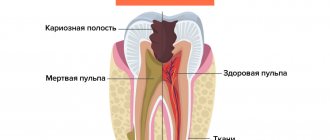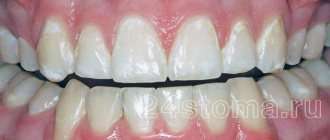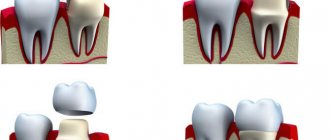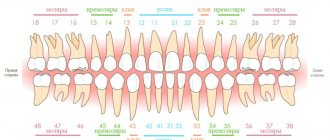Crown for a living tooth
When to place a crown on a living tooth
Stages of installing a crown on a living tooth
Types of crowns. Their pros and cons
When does pulp need to be removed?
Myths about dental crowns
The question of whether it is possible to put a crown on a living tooth has gathered many myths and prejudices and divided people into two camps. When you can put a crown on a living tooth, and when not, what are the pros and cons of both methods, we will consider in this article.
First, let's figure out what a living tooth means. A tooth is an organ consisting of a protective layer (enamel, dentin, cement) and a neurovascular bundle (pulp). A tooth is considered alive if the pulp is preserved, and dead if the pulp is removed - this procedure is usually carried out in the treatment of pulpitis and periodontitis.
Features and stages of implementation
Removal of the nerve leads to a gradual weakening of the structure of the dental tissue, which is caused by a disruption of the metabolic process. The result is a “fragile” unit, vulnerable to mechanical stress, so if possible, the doctor always decides to preserve the integrity of the pulp.
However, the procedure for installing an artificial crown on a living tooth is associated with a number of specific nuances that complicate the usual prosthetic algorithm. These include:
- The need to increase the volume of water supplied to the oral cavity during the preparation of the enamel layer, caused by the need for constant cooling of the internal structure of the pulp;
- Using a special attachment and a new drill, the cutting edge of which has never been used before. Otherwise, the level of friction turns out to be sufficient for overheating, and, as a consequence, death of the nerves;
- The use of a protective coating that limits the access of infections to the pulp chamber, as well as special antiseptic solutions in combination with an adhesive composition.
The preparatory stage involves installing a temporary crown on the treated tooth. Its functionality allows you to solve several significant problems at once, both practical and aesthetic. To make a permanent prosthesis, plaster casts are used, on the basis of which a zirconium dioxide or metal-ceramic element is formed, repeating the anatomical structure of the unit being replaced.
Important factors are considered not only the occlusal relationship, but also the aesthetic indicators of the artificial crown - it must match the shade of the other elements in order to create the impression of integrity of the dentition. The duration of laboratory fabrication varies from two to four weeks, after which the denture is tried on and adjusted, and then finally installed over the living tooth.
When to place a crown on a living tooth
A crown is a permanent cap-shaped structure that is similar in appearance to a natural tooth. Typically, a crown is installed on severely damaged teeth, when restoration with conventional filling materials is impossible or ineffective, since due to heavy loads, cracks may appear on the filling.
Indications for crown installation
- the tooth is destroyed by caries by more than 50%;
- the tooth is destroyed as a result of injury;
- the tooth has become gray or yellow, and stands out strongly against the background of other teeth.
Often, before installing a crown, the tooth is depulped, that is, the neurovascular bundle is removed from the root canals. However, in some cases this procedure is not carried out. The decision whether to perform depulpation or not is made by the doctor, based on clinical indications.
Cases when a crown is placed on a living tooth:
- the tooth is healthy, but due to destruction it cannot perform its functions;
- demineralization and fragility of enamel;
- using a tooth as a support for a bridge;
- destruction of the crown as a result of mechanical trauma;
- tooth loosening due to gum disease.
Why put a crown on a living tooth?
The neurovascular bundle (pulp) is the tissue that is located inside the tooth. It performs several functions: it delivers nutrients to the tooth and protects it from pathogenic microorganisms. After removal of the pulp, the tooth becomes fragile and vulnerable, as it is left without protection and does not receive nutrition, which leads to the destruction of enamel and the rapid development of caries. Therefore, preserving the pulp is a guarantee that the tooth can serve for many more years.
Sometimes after prosthetics, patients complain of toothache and swelling of the gums. This has nothing to do with the fact that the tooth was not pulpless. The main reasons are untreated diseases, incorrect technique when grinding down the enamel, and damage to the canals during preparation. If you experience these symptoms, you should make an appointment with your doctor.
Stump inlay and crown or filling for a pulpless tooth?
Developments in modern dentistry do not stand still. Based on various types of research, dentists are finding new and more advanced methods for restoring teeth. If your dentist 10 years ago was in favor of restoring the coronal part of a pulpless tooth using fiberglass pins and modern filling material, and today he claims that the only reliable way is a stump inlay and a metal-ceramic crown on the tooth, do not rush to accuse him of incompetence or desire for profit. Observations in practice show that pulpless teeth restored with an inlay and a crown last much longer.
Why does such a tooth need to be crowned?
When the pulp in a tooth is removed, the tooth ceases to receive the natural nutrition that it received when the nerve endings were preserved. The tooth becomes fragile, more susceptible to injury even from minor loads. The most unpleasant situation that can happen to such a “weakened” tooth is a chip of the tooth wall under the gum. When the wall of a tooth chips, capturing the part of the tooth located under the gum, its restoration becomes impossible, the dentists have only one verdict - removal. Which subsequently entails implantation and the cost of restoring a lost tooth becomes more expensive before our eyes.
Therefore, it is worth taking care in advance to ensure that your tooth remains in place intact and unharmed for many years, despite the fact that it has already been subjected to such serious treatment as nerve removal. Despite all the wonderful aspects of implantation, your own tooth is always better than an artificial one.
With deep caries, there is still a chance to leave the tooth “alive”. But even with such a diagnosis, the doctor will not give you a 100% guarantee that the nerve will remain in place. Despite the latest X-ray methods, in case of deep caries, the treatment plan is often determined after the fact, when the doctor has removed all the affected tooth tissue and it is already clear how far the pulp is from the filling. Sometimes it happens that it is possible to preserve the nerve, but after treatment for several weeks the patient may complain of pain when biting on this tooth, or a reaction to hot or cold. An experienced dentist will carefully listen to the patient’s complaints, how critical the pain is and, if they are tolerable, will give recommendations to wait a while. And it often happens that the pain subsides and does not return. But it also happens that you have to open the filling and treat the root canals.
What to do if the nerve needs to be removed?
When a problem is discovered that the inflammatory process has already progressed much further than even deep caries, ideally you need to go to an endodontist for dental treatment under a microscope. Because it is possible to clean and seal the canal efficiently only with the help of this modern equipment. An experienced endotontist uses a microscope to achieve a perfectly sterile effect in the canals. Subsequently, a correctly installed core inlay and crown do not give the slightest chance for microorganisms to penetrate into the root canals. When restoring the coronal part simply with filling material, such an effect is almost impossible to achieve.
A huge advantage of the stump inlay from pins is that it is securely fixed in the root canal to the optimal depth and provides an even distribution of the load on absolutely all areas of the tooth, preventing overload at any individual points.
Types of stump inlays.
The inlay can be of different types: collapsible and solid, which one should be installed directly in your case, your doctor will recommend to you.
Also, stump inlays differ in the material from which they are made:
- Metal.
- All-ceramic.
- An inlay made of a special alloy containing precious metals (widely used for people with allergies).
- Inlay made of zirconium dioxide alloy.
If a patient categorically refuses to restore a pulpless tooth by installing an inlay and a crown, our specialists, at the patient’s request, can restore such a tooth with a filling composite, but, alas, we do not provide a guarantee for such irrational treatment. Because it is very important for us to do our work for you efficiently, preserving your teeth for many years. And we are responsible for our treatment.
Some may view this approach as an attempt to make treatment more expensive than it could be, but no. Rather, the doctor who offers you to restore a pulpless tooth “without problems” using the most modern filling materials is seeking profit. Because such treatment will soon lead you to treatment again with the same tooth.
In our clinic you will receive high-quality treatment at all stages of dental prosthetics:
- The endodontist achieves ideal cleanliness and high-quality filling of the canals using treatment techniques under a microscope.
- The orthopedic dentist prepares the tooth cavity and takes impressions for the core inlay and subsequently for the permanent crown. The impressions are sent to the laboratory of our highly qualified technicians, with whom we have been collaborating for many years. And the requirements for them are as high as for our specialist doctors. The process of making a permanent crown takes place in several stages. The result is a perfect match of shape and color with your teeth. Until the permanent crown is made, the patient walks with a temporary crown and does not experience any discomfort when chewing, talking, or smiling.
- Our orthopedic dentists always use special dental binoculars, which are essentially an approximate analogue of a microscope, in order to achieve an ideal fit between the stump and crown.
Many patients are frightened only by the words and definitions themselves: “crown”, “prosthetics”. But it is precisely this approach that keeps a pulpless tooth functional and healthy much longer than one simply covered with a filling.
Stages of installing a crown on a living tooth
Installing a crown will require several visits to the dentist
Table 1. Stages of installing a crown on a living tooth
| Stage name | Procedures |
| Initial examination and diagnosis | Consultation with an orthopedist, examination of images, development of a treatment plan |
| Preparing to install a crown |
|
| Preparing a tooth for a crown | Using a drill, the doctor shapes the tooth so that the crown can be firmly attached to it. To do this, a layer of enamel is removed, the thickness of which depends on the thickness of the future crown. The procedure is performed under local anesthesia. |
| Making crowns | After preparation, the doctor takes impressions. Based on them, a plaster model is first made in a dental laboratory, and the crown is cast from it. If making a crown takes several days, the patient is given a temporary crown, which protects the tooth from bacteria and mechanical damage. |
| Fitting and fixation | Before installation, the doctor tries on the crown on the tooth. If the patient does not feel discomfort during fitting, the crown is fixed to the tooth using dental cement. |
Treatment of chronic pulpitis
For the treatment of chronic pulpitis, the patient was referred to an endodontist. In their work, Dial-Dent endodontists use special tools for treating dental canals, the latest methods of treatment and canal filling. Endodontists work with a microscope, processing the tooth canals carefully, without excessive expansion, without missing branches and unusually located canals, since an increase in the working field allows you to see what is inaccessible to the naked eye.
The endodontist isolated the tooth using a rubber dam. The tooth canals were cleaned and washed with sodium hypochlorite solution. Ultrasound was used to enhance the antimicrobial effect when treating tooth canals. The canals are dried and temporarily sealed with calcium hydroxide. The temporary filling remains for 2 weeks, during which the infection in the tooth canals is completely destroyed and inflammation is eliminated.
After 2 weeks, the canals are filled with AH+ material and gutta-percha. This filling method fills all branches and convoluted parts of the canals, sealing them hermetically. The tooth was restored with a light filling for further restoration with a ceramic crown.
Types of crowns. Advantages and disadvantages
Metal-ceramic crowns are rarely installed on a living tooth, since before installing such products, a significant layer of enamel must be removed. Therefore, metal-free structures are most often used: ceramics and zirconium dioxide.
| Ceramic crowns ➕ High aesthetics. Such crowns are indistinguishable from natural teeth. They are very light and almost imperceptible in the mouth. Ceramics can be used for people prone to allergies. ➖ high cost and fragility of the product. Ceramic crowns are not suitable for chewing teeth. |
| Zirconium dioxide crowns ➕ Considered the most in demand. Zirconium dioxide is a very strong and durable material. Just like ceramics, it looks natural, does not require significant grinding of teeth, and is hypoallergenic. ➖ high cost, not suitable for restoration of anterior teeth. |
When does pulp need to be removed?
Depulpation is not a mandatory procedure before prosthetics, but it cannot be avoided if there are the following indications.
- Advanced caries or caries at the very root of the tooth.
- Pulpitis or periodontitis.
- Partial exposure of nerves during grinding of enamel.
- Anatomically incorrect position of the tooth.
- Tooth injury, which may result in partial death of the nerves.
- Hypersensitivity.
- Low landing crown.
If there is a need to remove the nerve after the crown has been installed on a living tooth, then depulpation can be carried out without removing the crown. The doctor makes a hole, removes the nerve, and then fills the hole with polymer. After such a procedure, the prosthesis does not lose its performance properties.
Realities and myths
Most patients associate prosthetics, and especially if depulpation is excluded, with unpleasant sensations, pain and even fear.
This condition is explained by the need to remove part of the dental tissue, so many people refuse this method of tooth restoration, commenting on the following reasons:
- A tooth covered with a crown deteriorates and rots faster. This phenomenon does occur, but only if the procedure is carried out incorrectly and there is no proper care for the oral cavity.
Destruction is also possible due to inadequate preparation of the tooth for prosthetics, poor quality of the prosthetic product, or refusal to install a temporary crown. - To install a crown, a large amount of tissue will be removed from the tooth .
Dentistry today is focused on maximizing the preservation of dentin layers. Modern equipment and tools make it possible to control the amount of fabric stitching, and to carry out this procedure more carefully and accurately. In addition, materials for prostheses have also changed. Thus, the metal-ceramics became thinner, which enabled more gentle grinding behavior. - After the crown is removed, the tooth will need to be removed . If the border of the prosthetic product has not dropped, and the preliminary grinding of the tooth is done as carefully as possible, then repeated prosthetics will be successful in a few years, i.e. without the need for removal.
- Depulpation of a tooth that is to be covered with a crown is a mandatory procedure . Action is mandatory only if there are certain indications. Thanks to the introduction of innovative technologies in dentistry, attaching a prosthesis to a vital organ is not a problem.
- If caries has developed under the crown, the disease cannot be cured. It is possible, but the treatment method depends on the severity of the pathology.
In most cases, removal of the prosthesis and its subsequent replacement after completion of treatment is required. Often, caries can be eliminated in another way - without removing the orthopedic structure, treatment is carried out through the hole on the chewing surface. - Instead of a crown, it is better to put several fillings. From a financial point of view, filling is cheaper, but loses in efficiency. Fillings, even large ones, cannot withstand heavy chewing loads, which is why they split themselves and lead to the walls breaking off.
Important! The crown maintains uniform load distribution and protects tissue from destruction. If the tooth is severely damaged, fillings are not recommended.
All the considered reasons that underlie patients’ refusal to have crown prosthetics are misconceptions. It should be understood that only a dentist can offer the optimal treatment method, based on the results of the examination and visual examination.
From the video, find out the opinion of a specialist about whether it is necessary to kill the tooth under the crown.








